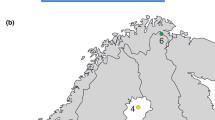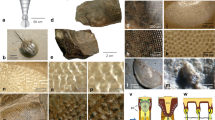Summary
The gross structure and optical properties of the eye of the marsh periwinkle,Littorina irrorata, are described. Each eye is about 270 × 240 μm in adults and is located on a short protuberance lateral to a cephalic tentacle. Light passes through a transparent cornea, a large fixed pupil, a spherical lens, and a large vitreous body, before striking a non-reflective retina. The lens is at least partially corrected for spherical aberration and has a short focal length (f/r = 2.71 for a 170-μm diameter lens in saline), indicating that its refractive index decreases from core to periphery. Rays parallel to the optic axis converge on the central retina's surface in a 1.1-μm diameter blur circle. The Airy disc on the central retina is less than 0.83 μm in diameter, indicating that image quality is nearly diffraction limited. The average adult retina contains about 7,450 photoreceptors whose average diameter is 3.44 μm, and whose average separation distance is 4.37 μm. On the central retina a single average photoreceptor subtends an angle of 1.3 ° from the posterior nodal point, while the angular separation of neighboring average photoreceptors is 1.7 °. Each eye has a potential field of view of 240 °, and the two eyes could provide 170 ° of forward-directed binocular vision. The depth of focus is estimated to be from 2.3 mm to infinity. The 5-mm long cephalic tentacles permit physical contact with objects too close to be in focus.
Similar content being viewed by others
References
Alkon DL (1976) Signal transformation with pairing of sensory stimuli. J Gen Physiol 67:197–211
Blest AD, Land MF (1977) The physiological optics ofDinopis subrufus L. Koch: a fish-lens in a spider. Proc R Soc London B 196: 197–222
Charles GH (1961) The orientation ofLittorina species to polarized light. J Exp Biol 38:189–202
Dawson RMC, Elliott DC, Elliott WH, Jones KM (1969) Data for biochemical research. Clarendon Press, Oxford
Fletcher A, Murphy T, Young A (1954) Solutions to two optical problems. Proc R Soc London A 223: 216–225
Gowanloch JN, Hayes FR (1926) Contributions to the study of marine gastropods I. The physical factors, behaviour and intertidal life ofLittorina. Contrib Can Biol Fish 3:135–165
Hamilton PV (1977) Daily movements and visual relocation of plant stems byLittorina irrorata (Mollusca: Gastropoda). Mar Behav Physiol 4:293–304
Hamilton PV (1978) The role of vision in adaptive oriented movements ofLittorina irrorata (Mollusca: Gastropoda) when displaced from their natural habitat. Mar Behav Physiol 5:255–271
Hamilton PV, Winter MA (1982) Behavioral responses to visual stimuli by the snailLittorina irrorata. Anim Behav 30: 752–760
Kirschfeld K (1976) The resolution of lens and compound eyes. In: Zeltler F, Weiler R (eds) Neural principles in vision. Springer, Berlin Heidelberg New York, pp 354–372
Land MF (1981) Optics and vision in invertebrates. In: Autrum H (ed) Handbook of sensory physiology, vol VII/6B, Vision in invertebrates. Springer, Berlin Heidelberg New York, pp 471–594
Lythgoe JN (1979) The ecology of vision. Oxford University Press, London
Mayes M, Hermans CO (1973) Fine structure of the eye of the prosobranch molluskLittorina scutulata. Veliger 16:166–168
Mortensen C, Eakin RM (1974) Efferent neurites to capsular muscles in the eye of a snail,Helix aspersa. J Ultrastruct Res 49:286–294
Newell GE (1958) The behaviour ofLittorina littorea (L.) under natural conditions and its relation to position on the shore. J Mar Biol Assoc UK 36:229–239
Newell GE (1965) The eye ofLittorina littorea. Proc Zool Soc London 144:75–86
Newell PF, Newell GE (1968) The eye of the slugAgriolimax reticulatus (Mull). Symp Zool Soc London 23: 97–111
Pumphrey RJ (1961) Concerning vision. In: Ramsay JA, Wigglesworth VB (eds) The cell and the organism. Cambridge University Press, Cambridge London
Smith JE, Newell GE (1955) The dynamics of the zonation of the common periwinkle (Littorina littorea (L.)) on a stony beach. J Anim Ecol 24:35–56
Vogt K (1974) Optische Untersuchungen an der Cornea der MehlmotteEphestia kühniella. J Comp Physiol 88: 201–216
Willows AOD (1973) Learning in gastropod mollusks. In: Corning WC, Dyal JA, Willows AOD (eds) Invertebrate learning, vol 2. Plenum Press, New York
Author information
Authors and Affiliations
Rights and permissions
About this article
Cite this article
Hamilton, P.V., Ardizzoni, S.C. & Penn, J.S. Eye structure and optics in the intertidal snail,Littorina irrorata . J. Comp. Physiol. 152, 435–445 (1983). https://doi.org/10.1007/BF00606433
Accepted:
Issue Date:
DOI: https://doi.org/10.1007/BF00606433




